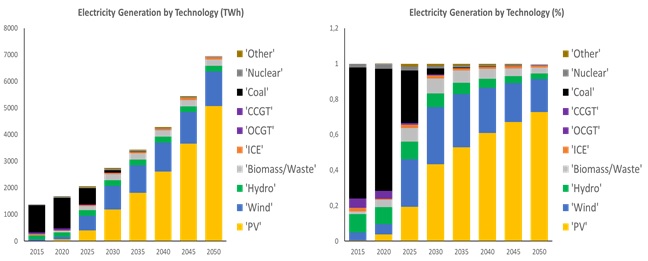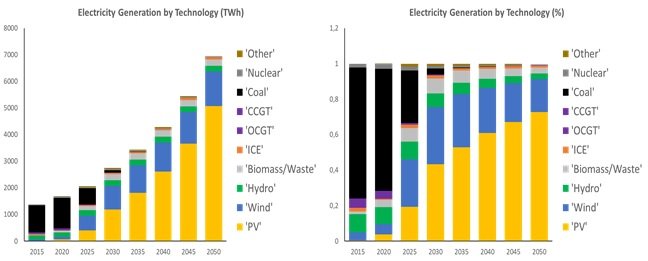The technology group Wrtsil and Lappeenranta-Lathi University of Technology (LUT) in Finland recently carried out a first-of-its-kind power system study exploring a carbon neutral power system across India by 2050.
India is currently faced with an energy trajectory that includes multiple imperatives: sustainability, energy access across the country and energy self-sufficiency, while most importantly driving and sustaining rapid economic growth. This joint study by LUT University and Wrtsil highlights the importance of a cost optimal and carbon-neutral power system in India by 2050. The study analyses the development of the power system in a Best Policy Scenario, in which greenhouse gas (GHG) emissions reach zero across the power sector by 2050 with comprehensive adoption of sustainable energy and flexible technologies.
Commenting on the study, Mr. Pieter Hokkeling, Director, Growth & Development, Middle East and Asia, Wrtsil Energy said, “Wrtsil’s team of power system modelling experts have systematically invested in building world class knowhow on modeling and analysing the long term environmental and economic impacts of the energy transition, and the need for flexibility in power systems with high shares of renewables across the world. This study focuses on understanding the value of flexibility in power systems beyond the limited scope of pumped storage hydro plants by integrating ICE (Internal Combustion Engines) and storage technologies (batteries and synthetic gas) in achieving a 100% renewable powered system. The study highlights that India stands to gain economically and environmentally by completely shifting towards a renewable powered electricity mix, with flexible technologies providing system reliability.”
Professor of Solar Economy, LUT University, Dr. Christian Breyer on collaboration with Wrtsil said, “We feel proud to partner with Wrtsil and contribute our expertise to this strategic modelling exercise. The research determined an economically viable pathway to a carbon neutral Indian power system by 2050, with electricity as the major energy carrier. The findings of the study have clearly resonated with Wrtsil’s vision of 100% renewable energy future. By combining our work with that of Wrtsil, this research has turned out to be an eye-opener.”
The study’s key findings include
-
Total LCOE on average is around 3120 INR/MWh (39 €/MWh) for 100% RE in 2050 in comparison to the total LCOE of 6000 INR/MWh (75 €/MWh) in 2020
-
The total installed capacity grows massively from about 400 GW in 2020 to around 4,000 GW by 2050, an increase of 10 times in the next three decades
-
The share of coal in electricity generation drops from 68% in 2020 to near zero by 2050 as cost effective renewables emerge as the predominant source of electricity generation
-
Gas engines (ICE) have a share of 1.1% in electricity generation in 2050, driven by higher efficiency and lower cost, with the vital role of providing peak supply and balancing
-
The installed electricity storage capacity will increase from about 22 TWh in 2030 to around 95 TWh by 2050. Storage output covers around 35% of the total electricity demand in 2050, of which 99% is contributed by batteries alone
-
The results of the power system transition across India indicate that GHG emissions can be reduced from nearly 1,166 MtCO2eq in 2020 to zero by 2050 across the power sector and enable the country to achieve its climate goals
-
The power transmission capacity increases by more than six times from 2020 to 2050. The cross-state electricity transmitted reaches close to 12% of the total electricity generated in 2050, indicating a key role for the development of transmission and distribution grids.
 |
Electricity Generation (TWh) by technology (left) and corresponding shares (right) during the energy transition from 2015 to 2050 across India
The study highlights urgent and continuous need for additional investments in renewable capacities and flexible technologies such as storage and ICE – for maintaining system reliability. Moreover, the study also underscores the importance of strengthening regional and interstate grids, mainly to reduce renewable curtailment and improve exchange of power across the country. Having said that, lots needs to be done on the ground to achieve carbon-neutral power system by 2050, including streamlining policy and regulatory framework at the national and state level and setting-up a balancing market for procurement of right kind of ancillary services during the time of need by the system operator.
Wrtsil Energy in brief
Wrtsil Energy leads the transition towards a 100% renewable energy future. We help our customers unlock the value of the energy transition by optimising their energy systems and future-proofing their assets. Our offering comprises flexible power plants, energy management systems, and storage, as well as lifecycle services that ensure increased efficiency and guaranteed performance. Wrtsil has delivered 72 GW of power plant capacity in 180 countries around the world.
Wrtsil in brief
Wrtsil is a global leader in smart technologies and complete lifecycle solutions for the marine and energy markets. By emphasising sustainable innovation, total efficiency and data analytics, Wrtsil maximizes the environmental and economic performance of the vessels and power plants of its customers. In 2020, Wrtsils net sales totaled EUR 4.6 billion with approximately 18,000 employees. The company has operations in over 200 locations in more than 70 countries around the world. Wrtsil is listed on Nasdaq Helsinki.
LUT University
LUT University (Lappeenranta-Lathi University of Technology) was established in Finland in 1969 and has served as a forerunner – combining technology and business. Its international community is comprised of 6,500 students and experts engaged in scientific research and academic education.
![]()






